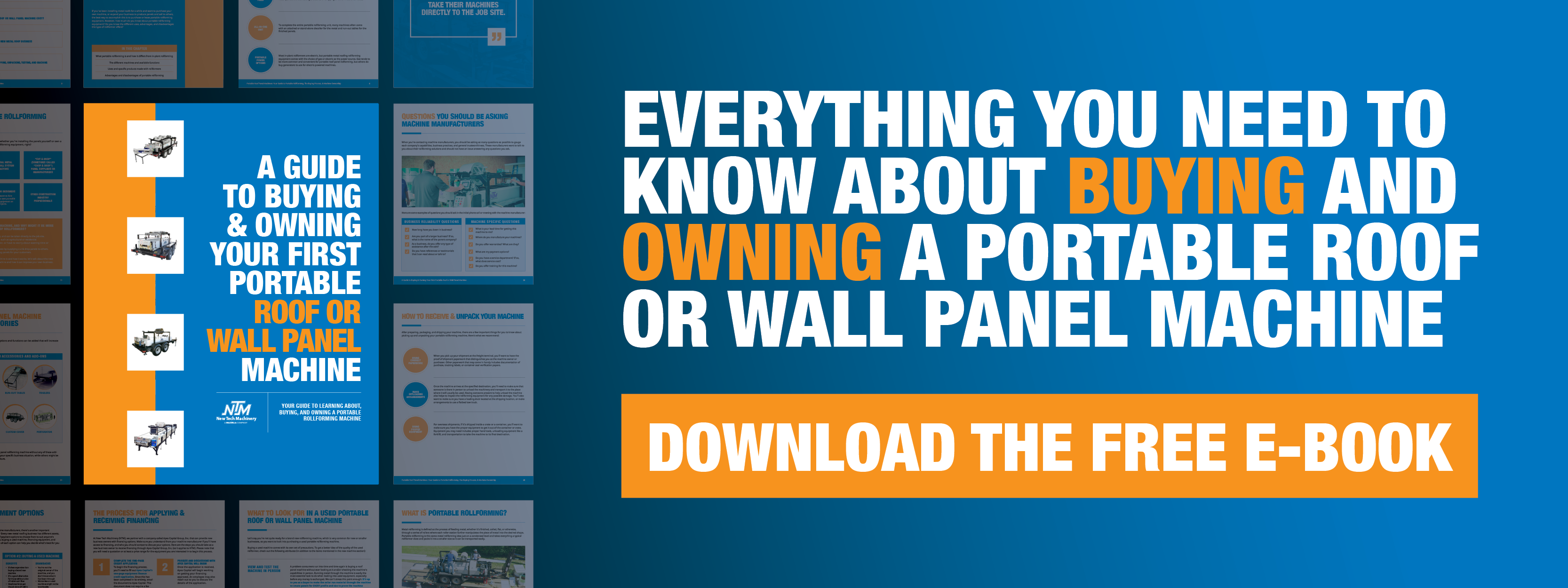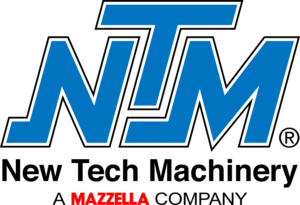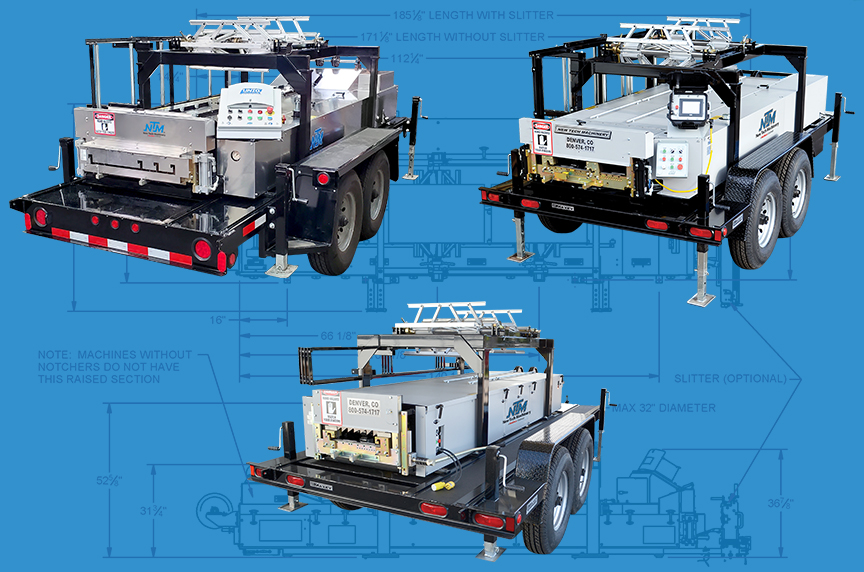
Why is knowing the roof panel machine footprint and specs, details about what profiles it can produce, and materials it can form helpful when making such an important purchasing decision? How can it ensure you’re operating your machine safely and properly?
At New Tech Machinery (NTM), we get asked what materials you can use with your portable roof panel machine, how wide a panel certain machines will produce, and how fast particular machines can operate. Knowing this information about your portable roof panel machine can not only help you make the best decision for your business as it stands now, but it also helps ensure that you’re selecting the right machine that can allow your business to grow in the future.
This article will explore and compare the specifications and details of each NTM portable roof panel machine: the SSR™ MultiPro Jr., SSH™ MultiPro, and the SSQ II™ MultiPro. We’ll also explain how you can use these specifications to choose which of these machines is the best fit for your metal roofing business now and potentially in the future.
What Are the Dimensions of the SSR, SSH, or SSQ II Portable Roof Panel Machines on an NTM Trailer?
One of the significant benefits of using a portable rollforming machine for your metal roofing business is that this machine is easily transportable to any job site. Understanding a machine’s footprint as it’s mounted to a trailer may help you decide which machine to purchase based on its towing requirements, weight, and what sizes of coils it can support.
Understanding machine dimensions and what they mean for you as a machine operator and for your business is critical for various reasons:
- You need to know the limits of what your vehicle can tow for both the machine and if you plan on transporting your machine with overhead reel racks and coil.
- A portable roof panel machine may not necessarily hold all coil sizes, so it helps ensure that you’re buying the right size and weight of the coil.
On an NTM trailer, here are the three portable roof panel machine specifications:
| SSR™ MultiPro Jr | SSH™ MultiPro | SSQ II™ MultiPro |
| Length: 18’ 11” | Length: 18’ 11” | Length: 18’ 11” |
| Width: 7’ 2-1/2” | Width: 7’ 2-1/2” | Width: 7’ 2-1/2” |
| Height with reel: 6’ 3” | Height with reel: 6’ 3” | Height with reel: 6’ 3” |
| Weight of base machine and trailer: 3,975 lbs. (includes roller set and rib rollers) | Weight of base machine and trailer: 4,620 lbs. (includes roller set, power pack, and rib rollers) | Weight of base machine and trailer: 5,090 lbs. (includes roller set, power pack, and rib rollers) |
Using the NTM-manufactured trailer with your portable metal roof panel machine has its advantages. The 12,000 lb. capacity trailer is designed and built for transporting and lifting a portable rollforming machine to a structure’s height.
The trailer is made of steel and built with steps for easy access to the top of your machine and its overhead reel rack. It also has jacks located near each trailer wheel for easy leveling and stabilization. Lifting lugs on all sides of the trailer allow easy lifting of the machine and trailer to a building’s height with a crane. Ensure that you adhere to the machine and trailer’s towing specifications and capabilities.
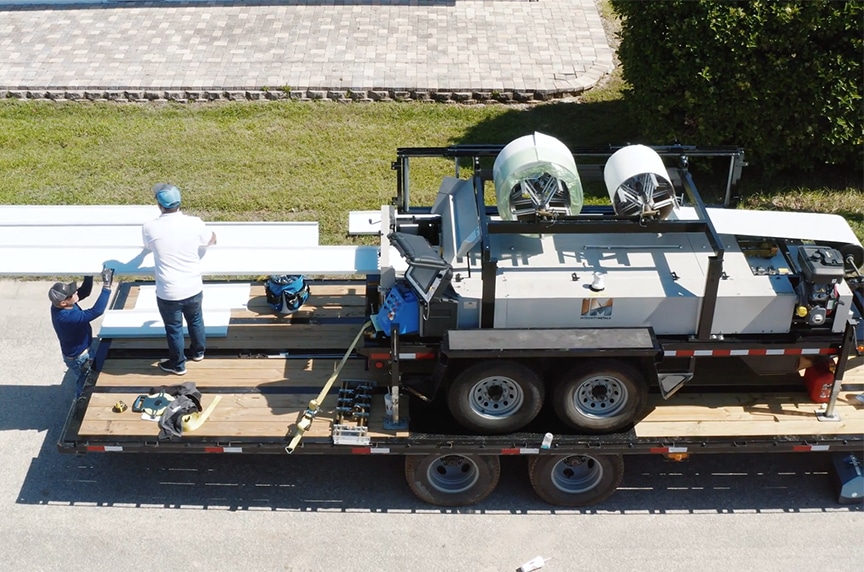
What Is the Roof Panel Machine Footprint of the SSR, SSH, or SSQ II Without a Trailer?
What is the machine footprint or specs of an NTM standing seam roof panel machine if you don’t use a trailer?
| SSR MultiPro Jr | SSH MultiPro | SSQ II MultiPro |
| Length: 12’ 6” | Length: 12’ 10” | Length: 14’ 4” Length with angled slitter: 15’ 4” |
| Width: 3’ 10” | Width: 4’ 10-1/2” | Width: 5’ 2” |
| Height with overhead rack: 4’ 3” | Height with overhead rack: 4’ 3” | Height with overhead rack: 4’ 3” |
| Height without overhead rack: 1’ 10” | Height without overhead rack: 2’ 0” | Height without overhead rack: 2’ 6” |
| Weight: 1,715 lbs. | Weight: 2,360 lbs | Weight: 2,830 lbs. |
Whether you want to use your own trailer for transporting your roof panel machine or choose to utilize your portable roof panel machine inside a plant or shop, knowing the dimensions of each machine without a trailer is crucial.
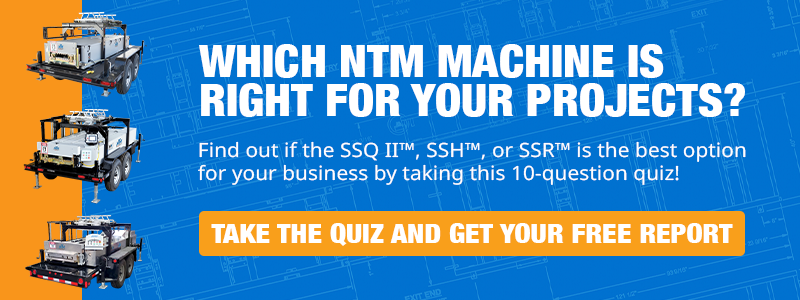
How Fast Can the SSR, SSH, or SSQ II Make Panels?
One of the best things about using a portable rollforming machine is that they can run longer lengths of panels quickly. Faster speeds are ideal for roofing companies that want to complete large commercial projects and produce panels faster and companies that focus on “chop and drop” business as they can get in and out faster and to the following job site.
| SSR MultiPro Jr | SSH MultiPro | SSQ II MultiPro |
| Approximately 30 ft./minute using electric power only | Approximately 60 ft./minute using gas power or electric motor | Approximately 75 ft./minute using gas power or 3-phase electric motor, and 51 ft./minute using single-phase electric motor |
Speeds of a portable roof panel machine can vary based on the type of motor (the SSR is slower because it only has a 1.5 horsepower motor) or the number of drive rollers to help material go through the machine.
What Power Source Does the SSR, SSH, or SSQ II Use?
The Quick-Change™ Power Pack (available for the SSH and SSQ II roof panel machines) lets you operate the machine at a job site using modular power, allowing you to switch from gas to electric power as needed at a job site. Using the gas motor will deliver the fastest operating speeds in the machine.
Having a modular power option for your portable roof panel rollformer has its benefits. For example:
- Even if accessibility to a particular power supply is limited, you can still use your machine.
- You don’t need as much equipment and can easily transport the power supply with your machine to each job site.
- Allows for easy and quick to change from one power source to another.
- It helps with the resale value of your portable rollforming machine.
- It allows for the versatility of using specific power sources based on your project, location, and available resources.
- You don’t have to buy two separate machines to operate both in-plant and on job sites.
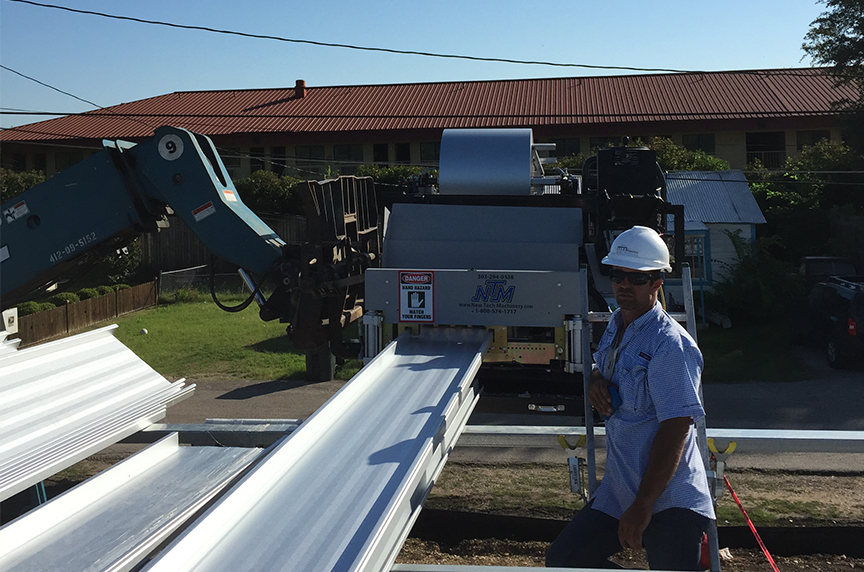
What Are the Maximum Coil and Finished Panel Widths for the SSR, SSH, or SSQ II?
One of the most important specifications to know when choosing a portable roof panel machine is what materials you can use to make metal roof profiles, the maximum thicknesses and widths of each material, and the finished panel width. Let’s dissect each of these features on each roof panel machine.
| SSR MultiPro Jr | SSH MultiPro | SSQ II MultiPro |
| Coil width: 15” to 20” | Coil width: 14” to 24” | Coil width: 15” to 30” |
| Finished panel width: 10” to 16” (depending on panel profile)* | Finished panel width: 10” to 20” (depending on panel profile)* | Finished panel width: 12” to 24” (depending on panel profile)* |
*Note: Confirm the minimum/maximum panel profile widths on your machine, because it could vary by each profile and machine.
On all machines (and the SSQ II without the angle slitting and notching functions), the overhead reel rack can support up to two 3,000 lb. (1,361 kg) coils for a total weight of 6,000 lbs. (2,722 kg). The SSQ II machine, with the optional notching and angle cutting system, can support up to two 2,700 lb. coils.
Knowing the coil weight, coil width, and finished panel widths is essential because it will help when buying material from your coil supplier. The material gets used up when forming the male and female legs of the profile. Most panels use between 4″ and 6″ of material to create a specific profile, so a 20″ wide coil would only make a 16″ wide finished panel profile. Also, if you want to adhere to an engineered system, you’ll need to know how wide your limitations are.
If you use coil widths or materials outside of the machine specifications, you could potentially damage the forming rollers or drive rollers, risk extensive oil canning on finished panels, or crash the panel into the exit end of the machine due to lack of clearance. You’ll want to consider the building application for your project and which profiles you’re planning to run also.
What Types of Metal Materials Can You Use With the SSR, SSH, or SSQ II Roof Panel Machines?
What types of materials can you run with each machine? The following materials have been tested by NTM for use on each machine with limited adjustments when switching from one type to another:
| SSR MultiPro Jr | SSH MultiPro | SSQ II MultiPro |
| 28 ga. to 24 ga. steel (painted, Galvalume, coated galvanized) | 28 ga. to 24 ga. steel (painted, galvanized, aluminized) | 28 ga. to 22 ga. steel (painted, Galvalume, aluminized) |
| .027” to .040” painted aluminum | .027” to .040” painted aluminum | .027” to .040” painted aluminum |
| 16 oz. to 20 oz. 3/4 hard copper | 16 oz. to 20 oz. 3/4 hard copper | 16 oz. to 20 oz. 3/4 hard copper |
Understanding what materials you can use with your portable roof panel machine gives you a variety of products you can offer to customers. Knowing the materials you can use with your machine helps your purchasing decisions if you have a coil supplier in mind.
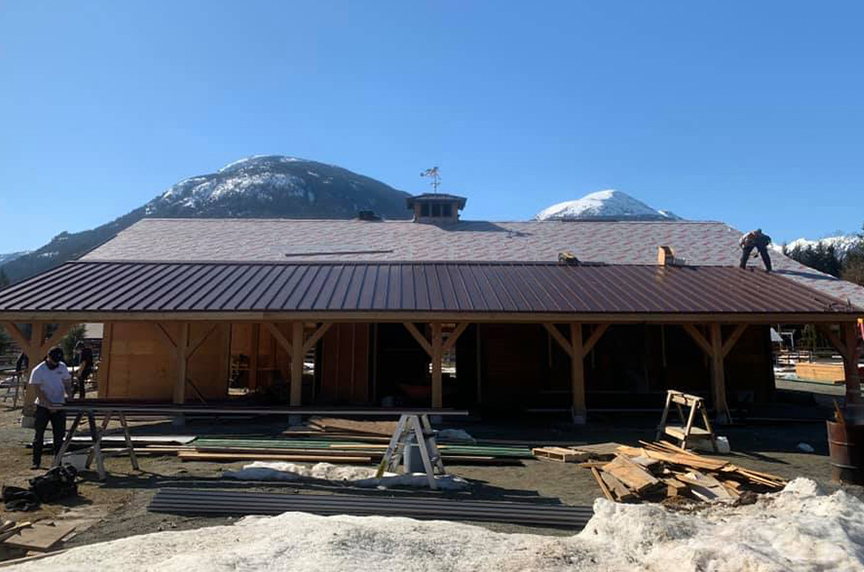
What Metal Roof Panel Profiles Can You Make With the SSR, SSH, or SSQ II?
All of the NTM portable roof panel rollforming machines can make a variety of metal roof panel profiles in different sizes and styles, and even some that are exclusive to New Tech Machinery. Each machine allows users to switch from one profile to another in an hour or less and may vary depending on which machine and profile you’ve chosen.
Let’s look at the panel profiles available with each NTM machine:
| SSR MultiPro Jr | SSH MultiPro | SSQ II MultiPro |
| 1” and 1.5” mechanical seam (SS100 and SS150) | 1” and 1.5” mechanical seam (SS100 and SS150) | 1” and 1.5” mechanical seam (SS100, SS150) |
| 1.5” Snap-Lock in two styles (SS450 and SS450SL) | 1.5” Snap-Lock in two styles (SS450 and SS450SL) | 1.5” Snap-Lock in three styles (SS450, SS450SL, SSQ550) |
| 1” and 1.5” Snap-Lock with slotted flange (FF100 and FF150) | 1” and 1.5” Snap-Lock with slotted flange (FF100 and FF150) | 1” and 1.5” Snap-Lock with slotted flange (FF100 and FF150) |
| T-Panel | T-Panel | T-Panel |
| 1” and 1.5” flush wall/soffit/underdecking (FWQ100 and FWQ150) | ||
| 1.75” Snap-Lock (SSQ675) | ||
| 2” and 2” ARMCO mechanical seam (SSQ200 and SSQ210A) | ||
| 2” Snap-Lock/mechanical seam proprietary profile (SSQ275) | ||
| 2.5” mechanical seam trapezoid (TRQ250) | ||
| Board and batten (BB750) |
The SSR and SSH machines are great for companies just getting started in metal roofing or for those who exclusively focus on the residential / light commercial markets.
With the most profiles available, the SSQ II machine allows you a wider range of profile styles in both residential and commercial applications to offer to customers. It also allows you to start with basic profiles initially and expand your offerings and business in the future, allowing you the option to provide more profile styles later or offer chop-and-drop services.
Final Thoughts
When considering purchasing a portable roof panel machine to add to your business operations, having a clear understanding of your machine footprint, capabilities, and features are essential to ensure you’re getting the most suitable machine for your setup and operations the first time around.
- Understanding the dimensions of a machine without a trailer can ensure that you’re getting a machine that fits on your trailer. If you want a machine mounted on an NTM trailer, knowing its towing and lifting capabilities can assist in your decision-making.
- Understanding a machine’s speed and power options helps you know if this machine can produce panels fast enough for your projects and if the power option is best suited for your projects.
- Knowing what materials you can run through your machine can help you ensure you don’t damage your machine or ruin material by running something that the machine can’t handle. It also helps to know when choosing a coil supplier.
- Finally, the number of profiles your machine can make certainly impacts the variety you can offer to customers or clients and if those profiles are popular in your region.
At New Tech Machinery, we understand that a lot goes into choosing the best portable roof panel machine for your business now and in the future. That’s why breaking down what’s important to know about each machine is helpful for your decision-making, budget, and customers. If you have any questions about our portable roof panel machines, add-on options, or the purchasing process, reach out to an Account Manager today.
